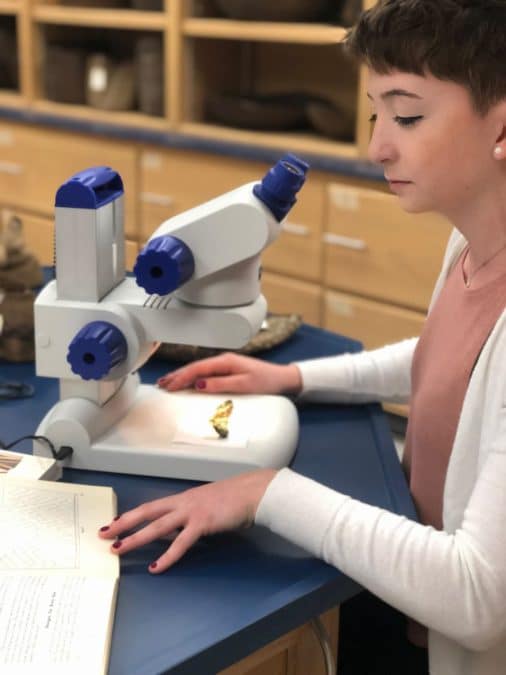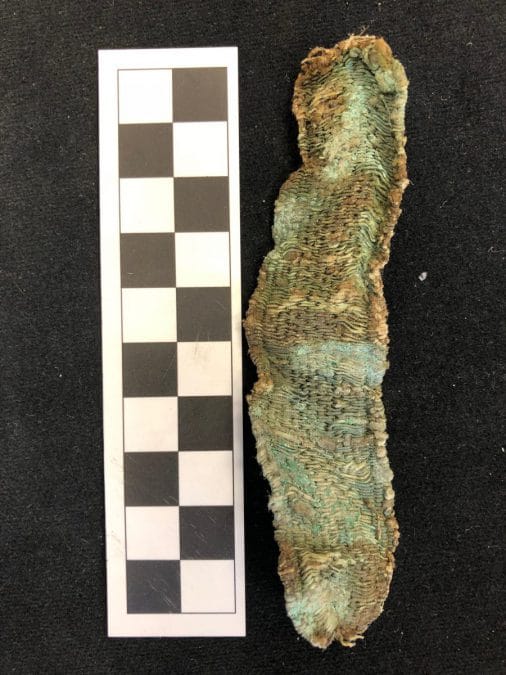Mercyhurst University in Erie, Pennsylvania, offers archaeology students a unique opportunity to work in a rare, well-furnished perishable artifacts lab. Student and Tribal member Kay (Kakendasot) Mattena completes her thesis research there with plenty of space and equipment to process and analyze relics. She will graduate with her Bachelor of Arts in anthropology/archaeology May 2019.

Initially a bio-archaeology major, over time, Mattena became more interested in general anthropology and archaeology. She focused her studies on preserved pieces of organic material prone to decomposition. During her work-study program, Mattena spent the majority of her time in the lab.
“Perishable artifacts are often rarely represented in the archaeological record just because of the nature of them being perishable,” she said. “But even looking around today, we know that … cloth, wood and those things that will eventually decay are a key part in our lives.”
Capstone project
Junior year forced Mattena to consider her senior thesis. Her adviser, Dr. Edward Jolie, offered a possible subject. Knowing her Tribal connection to the Great Lakes region, Dr. Jolie encouraged Mattena to analyze and rehydrate a textile from the area.
“It really was through like a miracle that this artifact was preserved, and it’s a 10-centimeter by 2-centimeter band or strap. It’s intricately twined, and it has a geometric zigzag decoration that goes throughout it,” Mattena said.
The United States Forest Service archaeologist at Hiawatha National Forest Dr. Eric Drake and Distinguished Professor of Anthropology at Illinois State University Dr. James Skibo excavated it. It was the only perishable artifact found during their time at a Late Woodland Period site near Williams Landing on Grand Island, Michigan, called Gete Odena, or “The Ancient Village” in Ojibwe.
The fabric’s proximity to copper aided its preservation. The reshaping process allowed her to brush off the crystalline copper, which provided a detailed look.
“We were lucky enough that it took to the reshaping very well, and we were able to get it laid all the way out and found that it was a band or a strap of some sort,” Mattena said.
“It’s actually pretty soft and pliable. It almost feels like a flannel texture now, whereas before it felt very stiff and brittle.”
In October 2018, the Midwest Archaeological Conference selected her to give a presentation about the artifact and her research’s success. Afterward, she continued her work, replicating the piece and attempting to understand its creation.

“It’s a way that we express ourselves as human beings through our clothing, our dress, our body adornment, the things we make with our hands. Our expression of ourselves,” she said. “If we can look at those artifacts, those textiles, those baskets, we can get a glimpse of what the people did in the past to express themselves.”
Ancestry to artifact
Given the oral nature of most Potawatomi and Nishnabe traditions, finding physical remnants of the culture assures Mattena of the essential combination of archaeology and anthropology.
“I always get so excited when we find stuff that is a part of bodily adornment or like regalia that I’m familiar with. Finding tinkler cones (traditionally on jingle dresses) the first time gave me goosebumps,” she said.
A Navarre descendant, Mattena and her family lived in Salt Lake City, Utah, and moved to Tennessee when she was 16. Her grandmother exposed her to Potawatomi culture the most by passing down a lullaby in the traditional language.
Mattena attended school with members of the Church of Jesus Christ of Latter-day Saints as a child and describes the experience as “rough.”
“I learned quickly in elementary school, you don’t tell people you’re Native” she said. “I was told after my peers saw my mom who has a copper skin tone that I was going to go to hell just because I had Native in me.”
Her grandmother died, and Mattena and her family began exploring their Potawatomi heritage. A few years ago, Mattena’s mother hosted a naming ceremony with an outdoor fire at her house and asked CPN Representative Eva Marie Carney to name them. Mattena received the name Kakendasot, meaning “Always Learning.”
“It was cool because it was one of the first times that I had heard the Bodewadmi (Potawatomi) language being used, and I just didn’t think I could hear anything more beautiful,” she said.
She took the desire to learn more about Native culture with her to college, completing her degree with a thesis close to her heart.
“A huge part of this project and me going into anthropology is me trying to navigate my own identity as a mixed Native girl, too,” she said.
She plans to continue her exploration by starting graduate school in the fall. The University of Massachusetts Amherst recently accepted her into the anthropology program, and Mattena wants a concentration in Indigenous studies.
“We’re finding now and kind of exposing dominant ideologies that we as Native Americans deal with, especially mixed Native Americans, and our identity construction that the normal public doesn’t have to deal with,” she said.
Her research will focus on the high rate of sexual violence against Native American women as well as the many issues of claiming heritage.
“I think we have this ideology in America that you have to pick one, but I love every aspect of my heritage,” she said. “From my Native to my Sicilian to my Scotch-Irish, I love it all.”
To provide or learn more information about the artifact, contact Kay Mattena at kmatte37@lakers.mercyhurst.edu. Discover more about Potawatomi history and customs at potawatomi.org/culture.
